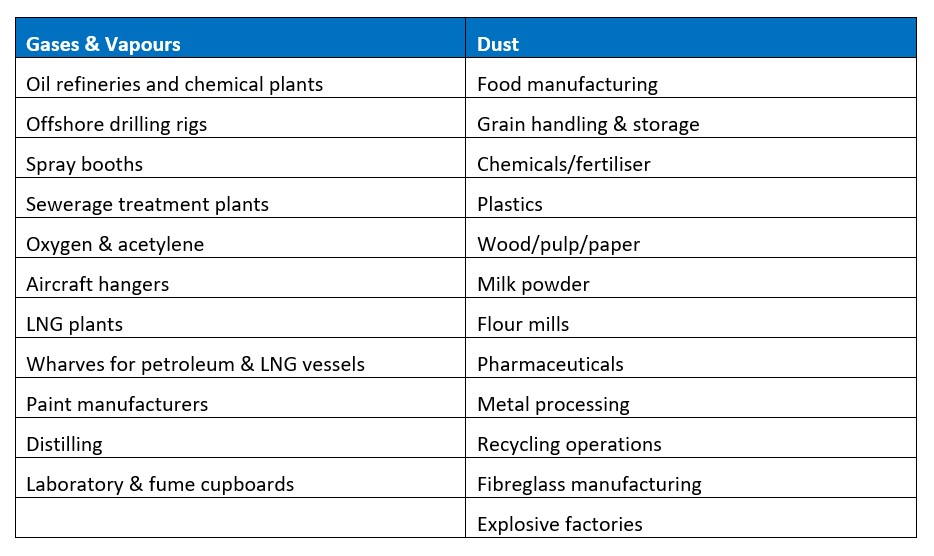The Facts About Roar Solutions Uncovered
The Facts About Roar Solutions Uncovered
Blog Article
Getting The Roar Solutions To Work
Table of ContentsFacts About Roar Solutions RevealedNot known Incorrect Statements About Roar Solutions Top Guidelines Of Roar Solutions
In such an atmosphere a fire or surge is feasible when three basic conditions are fulfilled. This is usually referred to as the "hazardous location" or "combustion" triangular. In order to safeguard installments from a possible surge a method of analysing and categorizing a potentially hazardous location is required. The function of this is to make sure the right choice and setup of tools to eventually avoid a surge and to guarantee safety and security of life.
(https://www.reddit.com/user/roarsolutions1/)
No devices needs to be set up where the surface area temperature level of the tools is above the ignition temperature level of the offered danger. Below are some common dirt unsafe and their minimum ignition temperature. Coal Dirt 380C 225C Polythene 420C (thaws) Methyl Cellulose 420C 320C Starch 460C 435C Flour 490C 340C Sugar 490C 460C Grain Dirt 510C 300C Phenolic Material 530C > 450C Aluminium 590C > 450C PVC 700C > 450C Soot 810C 570C The likelihood of the hazard existing in a concentration high adequate to create an ignition will vary from area to location.
Harmful location electric equipment possibly developed for use in higher ambient temperatures. Area Repair Service By Authorised Employee: Complex screening may not be required nonetheless certain treatments might need to be followed in order for the equipment to keep its third event score. Each item of devices with an unsafe rating ought to be reviewed independently.
Examine This Report about Roar Solutions
The tools register is a comprehensive data source of equipment records that includes a minimum set of fields to recognize each item's place, technical criteria, Ex lover category, age, and ecological data. This information is vital for tracking and handling the equipment successfully within hazardous locations. In comparison, for periodic or RBI sampling assessments, the quality will be a combination of In-depth and Close evaluations. The ratio of Detailed to Shut evaluations will certainly be figured out by the Equipment Risk, which is evaluated based upon ignition risk (the probability of a resource of ignition versus the likelihood of a combustible environment )and the dangerous area category
( Area 0, 1, or 2). This variation will also influence the resourcing requirements for work preparation. Once Whole lots are specified, you can establish tasting plans based upon the sample size of each Lot, which refers to the number of arbitrary devices items to be evaluated. To establish the required example size, two elements require to be evaluated: the size of the Great deal and the classification of inspection, which shows the degree of initiative that need to be applied( lowered, normal, or enhanced )to the inspection of the Whole lot. By incorporating the category of evaluation with the Great deal dimension, you can after that establish the proper being rejected standards for a sample, suggesting the allowable variety of faulty items located within that example. For even more information on this procedure, please refer to the Energy Institute Guidelines. The IEC 60079 standard recommends that the maximum period in between examinations must not go beyond 3 years. EEHA inspections will certainly additionally be carried out outside of RBI campaigns as component of scheduled maintenance and equipment overhauls or repair work. These evaluations can be credited toward the RBI sample dimensions within the influenced Lots. EEHA assessments are performed to recognize mistakes in electrical equipment. A weighted scoring system is necessary, as a single tool might have several faults, each with differing levels of ignition risk. If the consolidated rating of both assessments is much less than twice the mistake score, the Lot is considered appropriate. If the Lot is still thought about unacceptable, it has to undergo a complete examination or validation, which may set off stricter assessment protocols. Accepted Lot: The root causes of any type of mistakes are identified. If a typical failing setting is discovered, extra devices might call for maintenance. Faults are categorized by extent( Security, Stability, Housekeeping ), ensuring that urgent issues are examined and resolved immediately to alleviate any type of influence on safety and security or operations. The EEHA data source need to track and record the lifecycle of mistakes in addition to the rehabilitative actions taken. Implementing a robust Risk-Based Inspection( RBI )approach is vital for making certain compliance and security in taking care of Electric Equipment in Hazardous Areas( EEHA) (eeha). Automated Fault Rating and Lifecycle Monitoring: Effortlessly handle faults and track their lifecycle to improve evaluation precision. The intro of this assistance for risk-based assessment additionally enhances Inspectivity's setting as a best-in-class remedy for governing compliance, in addition to for any kind of asset-centric inspection usage case. If you have an interest in discovering more, we invite you to ask for a presentation and discover exactly how our option can transform your EEHA management procedures.
Roar Solutions Things To Know Before You Buy

In terms of explosive risk, a harmful location is an environment in which an explosive environment is existing (or may be expected to be existing) in amounts that need special precautions for the building, installation and usage of devices. electrical refresher course. In this post we discover the difficulties encountered in the work environment, the risk control steps, and the required expertises to work securely
It issues of modern-day life that we manufacture, store or handle a range of gases or liquids that are regarded flammable, and an array of dusts that are considered flammable. These materials can, in certain conditions, develop explosive ambiences and these can have significant and tragic consequences. The majority of us know with the fire triangular get rid of any type of among the 3 components and the fire can not occur, but what does this my review here mean in the context of unsafe locations? When damaging this down right into its simplest terms it is essentially: a mix of a specific quantity of launch or leak of a particular compound or material, blending with ambient oxygen, and the visibility of a resource of ignition.
In most circumstances, we can do little about the degrees of oxygen in the air, yet we can have considerable impact on sources of ignition, for instance electric tools. Dangerous locations are documented on the hazardous location classification drawing and are identified on-site by the triangular "EX-SPOUSE" indicator. Below, among other vital details, areas are divided right into 3 kinds depending upon the hazard, the probability and duration that an explosive ambience will exist; Zone 0 or 20 is deemed one of the most dangerous and Zone 2 or 22 is considered the least.
Report this page